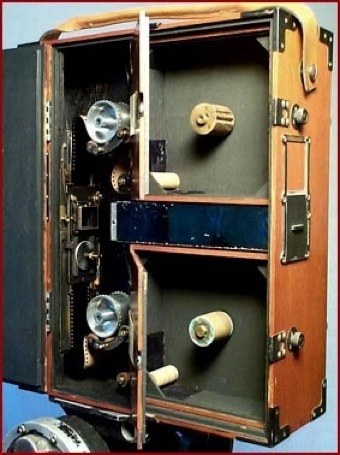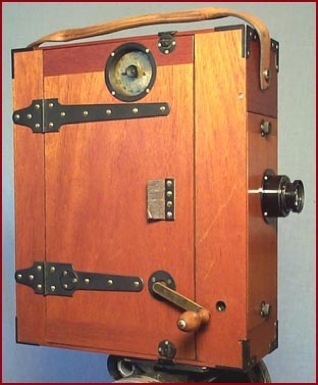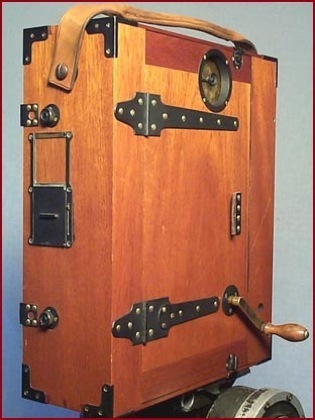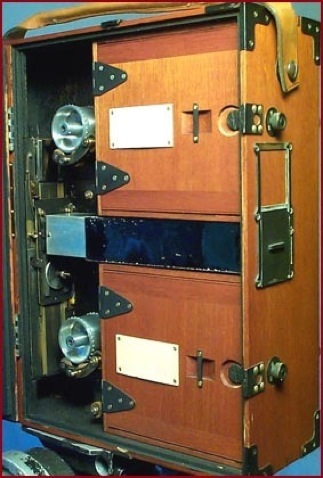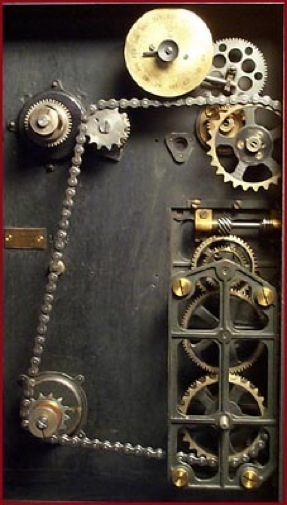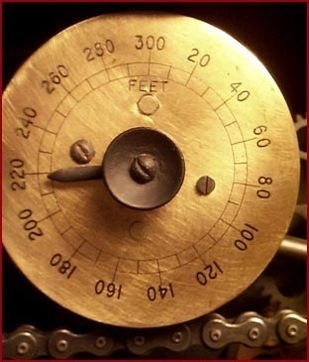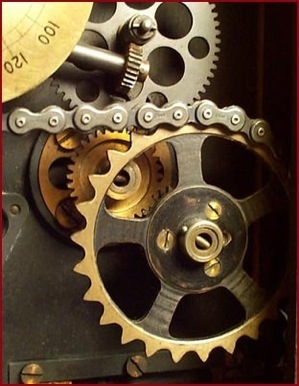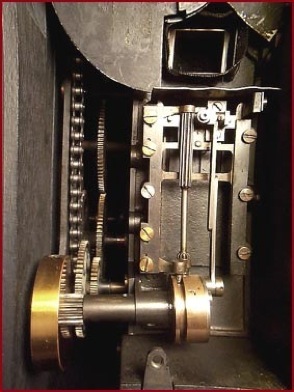
Three Color Moy & Bastie Camera #136
ca. 1909
Extremely Rare
(New Discovery)
Price upon Request
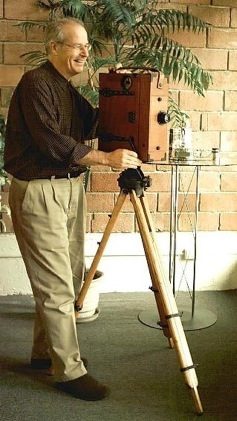
In 2003 I traveled Europe and the USA looking at professional 35mm movie camera collections. What I have seen is a huge variety of cameras and an even greater range of quality and condition. Nowhere was there a camera and tripod in this fine condition. I have to say this is a unique camera. Further in the text you will read about this camera's unique mechanics but here I want to describe cosmetics. I can't stress what a fine example of an original camera this is. I didn't see anything even close to this in the British Museum's collection, the Paris Cine Museum, or in any of the many private collections. This camera is as close to the day it was made as anything I have ever seen. I believe this to probably be the finest example of an early, pioneer wood hand cranked camera in existence. AND…
After about seven very confusing years I was finally able to figure out what this camera’s specialty is. While researching the two-color Kinemacolor camera found elsewhere on this website I actually found a three-color camera in a collection in England. It was beat up very badly but the mechanism was there and it was the shutter combination on that camera that lead to the discovery of #136 being an extremely rare three-color camera.
The time period I am writing about here is the Genesis era of the motion picture industry. The people on these Moy #136 pages are from the Genesis era. This is well before the time of the pioneers like Mary Pickford or Douglas Fairbanks started their run at the industry. Edward R. Turner first patented the three-color film process in 1899 with the financial aid of Charles Urban. Turner died from a heart attack in his laboratory in late 1903 and Charles Urban gave the project over to George Albert Smith in 1904. It seems like they continued to try to make the three-color process viable even after they patented a two-color process in 1906.
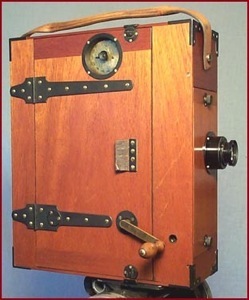
Specialty cameras are so rare that there really isn't an equitable way to price them. Represented here is Moy and Bastie camera #136. I have not seen any Moy serial numbers start lower than 100, which leads me to believe that, like most camera makers, 100 is where they started their serial numbers. That places this camera's manufacture date right at 1908/09.
Here is a paragraph I wrote about this camera about seven years ago:
“This is an astounding camera. It does a very strange thing. I believe this may be an extremely important camera in the development of the movie industry. If I knew why it does what it does, I would understand its significance. Could this be an experimental color process camera? Or...??”
As it turns out, it is a very important early experimental color camera.
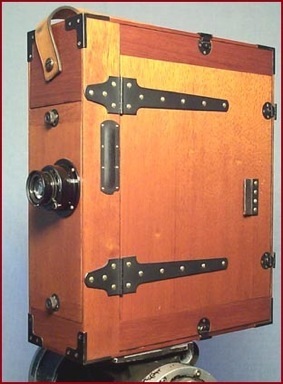
Experimental camera Moy #136 shots anywhere between 8 fps and 32 fps and has two shutters that run at different speeds. The black shutter closest to the lens has an opening of about 160 degrees and runs at the speed of a normal shutter. The second Aluminum colored shutter is driven by another gear on the main shutter driving shaft. The second shutter runs at one third the speed of the primary one. The second shutter has spaces for three primary color filters, red, blue and green. Fortunately I was able to have the three-color shutter from the camera in England duplicated. #136 had all the mechanics and gears already in place so it meant simply duplicating the circle with the three openings in it and this camera was now back to being a complete three-color camera.
The three-color system was brilliant in thought but had a flaw that just couldn’t be overcome. The idea was that every third frame of black and white film would be exposed through a red, blue or green filter. This would make the image exposed to that color have black or very dark areas where that color was exposed on the film. If a woman had on a red dress then the red filter would make that dress nearly black on the negative. When processed and printed on the positive print the red dress would become transparent. Then the print was projected back through a shutter/color wheel with the three colors aligned with their original color exposed frames and the movie screen would flash red,blue,green,red,blue,green and the red dress would be red. Human persistence of vision would meld the three different color frames and the audience would be seeing color movies.
For this to work the camera had to run at forty-eight frames per second and the film had to be projected back at forty-eight frames per second. Human persistence of vision doesn’t work at forty-eight FPS. The flashes are too short to leave a lasting registration on the retina. Oddly enough two-colors would work as the flashes were at thirty-two frames per second but the blue filter had to be left out of the equation. Another quirk of human persistence of vision came to light. Having seen color all its life the part of the human brain that distinguishes color simply filled in blue where it was normally seen. Blue sky became blue even when the sky was not colored in the two-color system.
Shooting and projecting at forty-eight frames per second wore out the prints quite quickly and projector jambs were very common. The whole process cost more than six times a normal black and white movie and that is only the film costs. The cameras and projectors had to be made specially and required special operators and yet the box office prices couldn’t reflect the higher production costs. Real color movies were going to have to wait more than another twenty years.
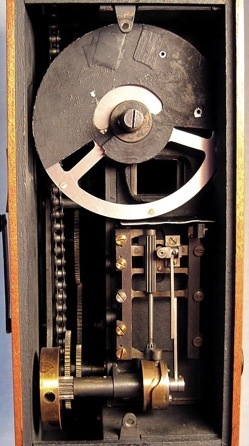
Now on to the cosmetics and mechanics of the camera; The Mahogany on this camera is unusually damage free. This camera never seems to have gone out into the field. I believe it always worked in a lab or in the studio. The movement is wonderfully free and easy to crank. All the brass on the outside is a flat black. This is to stop reflections from affecting the subject being filmed and is seen mostly on special effects cameras. The aperture area has had some adaptations that lead me to believe that the camera was used for color and that it normally didn't run at the standard speed but at a higher exposure rate. The metal shield under the aperture is to stop stray light from getting to the film from the "drunken screw" area of the mechanism. Black velvet cloth artificially stiffened and placed around the aperture is meant to extend it out to the rear of the Aluminum shutter to stop stray light from getting to the film. The movement has almost no wear in the mechanism indicating that the camera was most probably only used to shoot color in the lab. This camera just didn't get the kind of exterior wear and tear that a field camera gets by being taken in and out of cases and trucks and cars. I am surprised at what a truly beautiful camera this is.
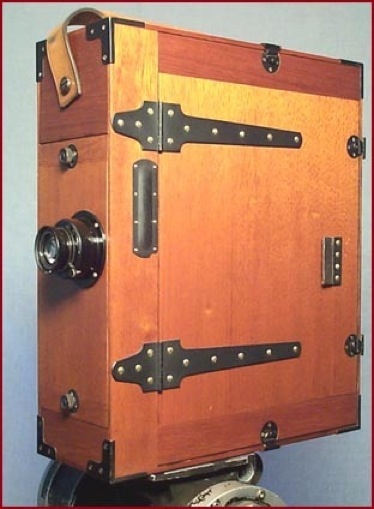
The film magazines hardly look used at all. Their interior is very clean and undamaged. I have never had a camera that looks like this before, and I probably will never have a camera in this condition ever again. I don't think there is another that is this pristine anywhere. Remember, it’s over a hundred years old.
The lens has the following printing on it: "Emil Busch A.-G. Rathenow Busch Glaukar Anastigmat F:3.1 F=7.5cm" I love lenses made this early as they have F stop markings that we don't see today. I believe these markings went out of use around 1910-15. They are: 3.1, 4.5, 6.3, 9, 12, 18, and 25. The glass is really clean and the lens focuses smoothly and easily. This camera is capable of shooting today, and I'm so confident of its excellent condition, that I'm not even going to steady test it.
